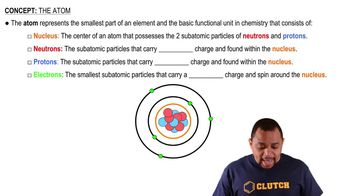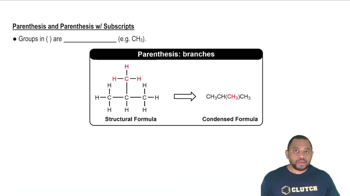Here are the essential concepts you must grasp in order to answer the question correctly.
Chemical Formula Interpretation
A chemical formula represents the types and numbers of atoms in a compound. In the formula Ca(NO2)2, 'Ca' stands for calcium, while 'NO2' indicates a nitrite group. The subscript '2' outside the parentheses means that there are two nitrite groups in the compound, which affects the total count of nitrogen and oxygen atoms.
Recommended video:
Intepreting the Band of Stability
Counting Atoms in Compounds
To determine the number of each type of atom in a compound, one must account for both the elements present and their respective subscripts. For example, in Ca(NO2)2, there is one calcium atom, two nitrogen atoms (from 2 x NO2), and four oxygen atoms (from 2 x 2 in NO2). This systematic counting is essential for understanding the composition of the compound.
Recommended video:
Parentheses in Chemical Formulas
Parentheses in chemical formulas indicate that the enclosed group of atoms is a distinct unit that can be multiplied by a subscript. In Ca(NO2)2, the parentheses around NO2 signify that the entire nitrite group is repeated twice, which is crucial for accurately calculating the total number of each atom in the compound.
Recommended video:
Parenthesis and Parenthesis w/ Subscripts

 Verified step by step guidance
Verified step by step guidance


